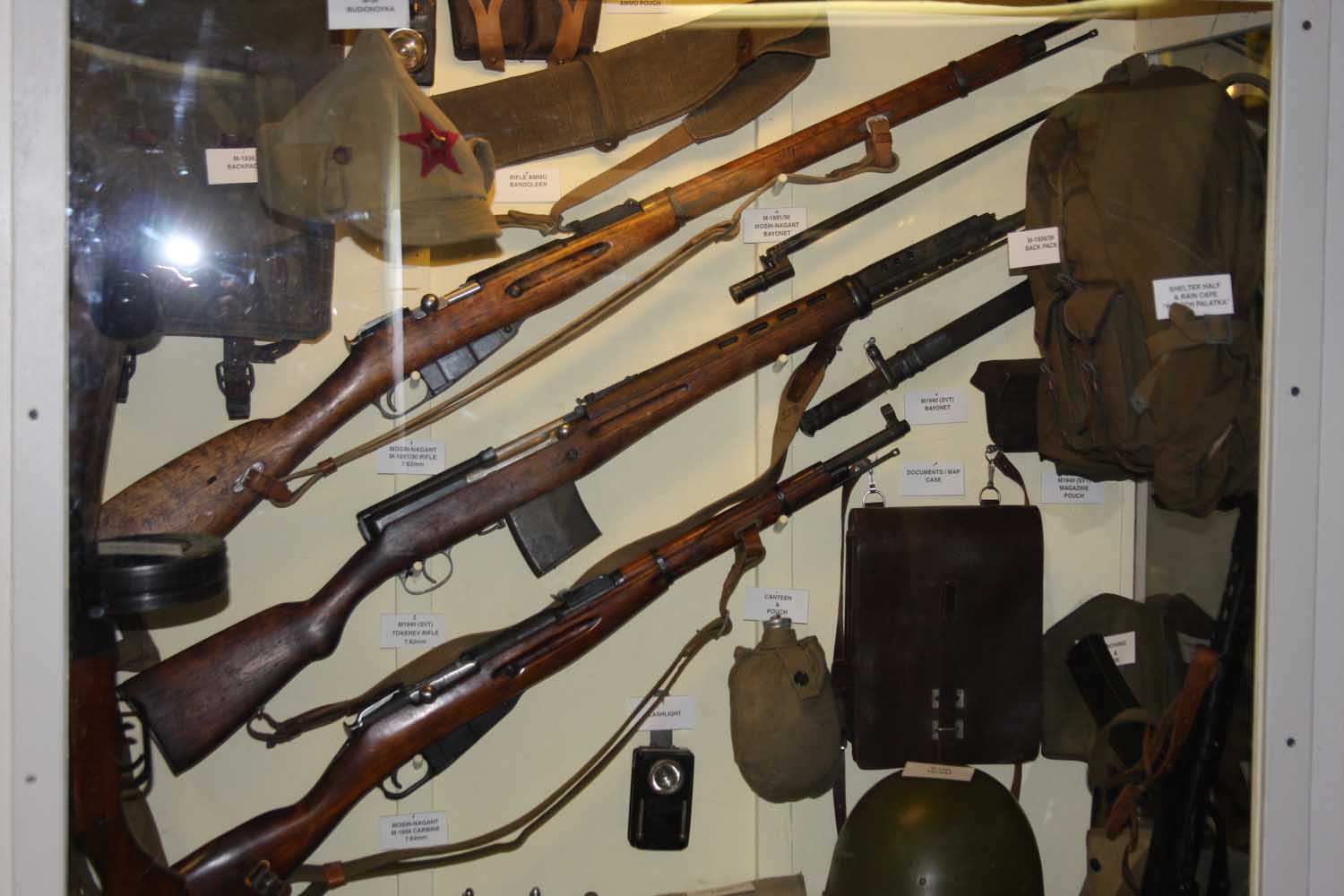Russian DP 28 Light Machine Gun:
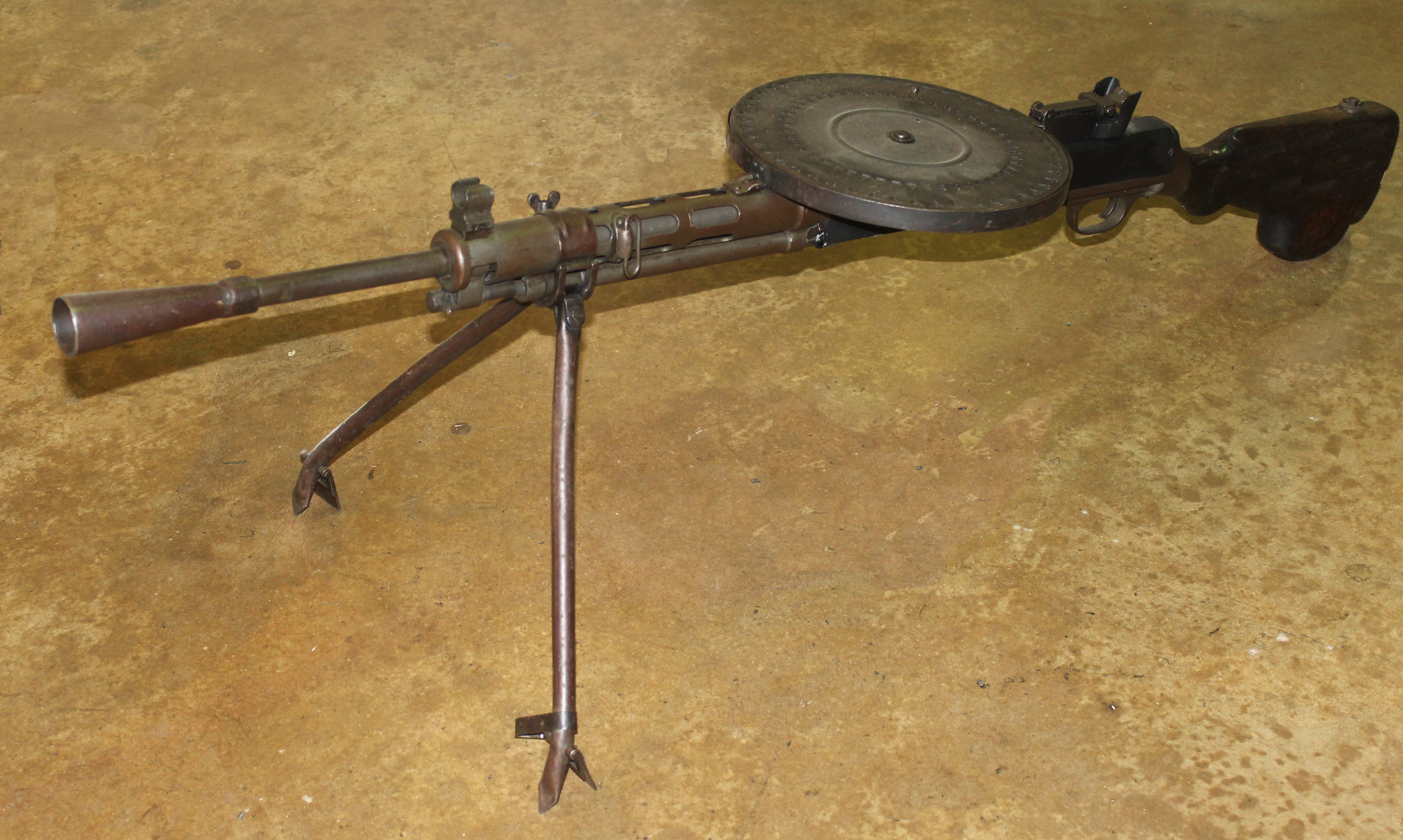
The DP 28, also known as the the Degtyaryov machine gun is a light machine gun firing the 7.62×54mm cartridge. It was developed in 1928 and was primarily used by the Soviet Union. It was the primary light machine gun for Soviet infantry during World War II. It was used in aircraft and almost all Soviet tanks of Wolrd War II. As was the case with many light machine guns of World War II, the DP28 used the same ammunition as the standard battle rifle of the period, which in the case of the Red Army was the 7.62 caliber used by the Mosin Nagant rifle. This standardization simplified logistics for Soviet infantry units. Similar to many other Russian designs, the DP28 was sturdy, cheap to manufacture, and reliable under adverse conditions. The DP 28 is gas-operated and fires at a relatively slow cyclic rate of 550 rpm, much slower than similar German light machine guns. The DP 28 uses a distinctive round, flat magazine that holds 47 rounds and fits on top of the receiver. The magazine rotates as the weapon is fired. This earned the DP 28 the nickname "record player". The first versions of the DP 28 only contained 80 parts. Known weaknesses were the magazine pan which was prone to damage when being carried, and the poorly designed bipod. Unlike belt-fed weapons, the DP 28 was incapable of prolonged periods of sustained fire because of the 47 round magazine. The magazine was also laborious to reload. Despite these drawbacks, the DP 28 was considered an effective weapon. The DP 28 has also been used by the Chinese Communists, the NVA, and the Viet Cong.
Mosin Nagant M 1891 Rfile:
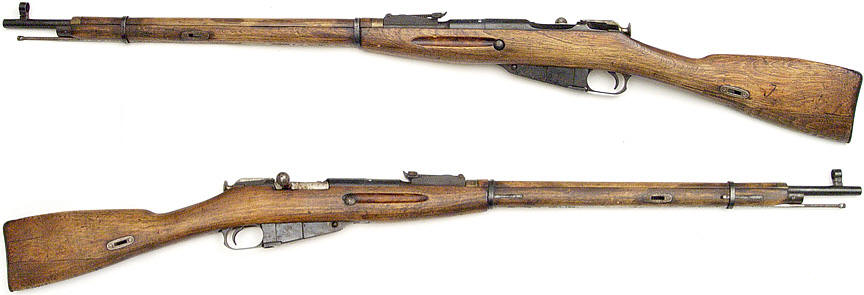
The Mosin Nagant rifle is a 5 shot bolt action rifle fed by an internal magazine. The rifle was produced in large numbers by the Russian Empire , Soviet Union and other nations with over 37 million produced. In spite of its antiquity, it is still used in modern conflicts around the world. It is typically found chambered for the 7.62×54mm R cartridge. During the Russo-Ottoman War of 1877–1878, Russian troops, equipped with single shot rifles suffered extreme disadvantage when facing infantry armed with more modern repeating rifles. A development initiative involving three competing rifle designs submitted by Mosin, Nagant and Zinoviev eventually resulted in what became the 1891 Mosin Nagant with Mosin's design being favored over the Nagant design. However, Nagant was able to leverage patent issues to acquire a substantial payment from the Russian government and continued to make substantial contributions to weapons development such as the Nagant revolver. The 1891 rifle was not known in Russia at the time as the Mosin Nagant, a term which was produced by Western literature. The rifle was actually known as the Russian 3-line rifle M1891. Production began in 1892 at the ordnance factories of Tula Arsenal, Izhevsk Arsenal and at Sestroryetsk Arsenal. The first major combat action for the Mosin Nagant rifle was The Russo-Japanese War (1904–1905). Due to the shortcomings of a still-developing domestic industry, the Russian government was not able to produce enough of their own Mosin Nagant rifles and instead ordered 1.5 million M1891 infantry rifles from Remington Arms and another 1.8 million from New England Westinghouse Company in the United States in 1915. The Mosin–Nagant 91/30 was the standard issue weapon of Soviet troops during WW2 and millions of the rifles were produced. After WW2, production of the Mosin Nagant rifle ceased as more modern designs such as the SKS and AK began to dominate. Virtually every country that received military aid from the Soviet Union, China, and Eastern Europe during the Cold War used Mosin–Nagants.
The Mosin-Nagant 1891/30 was modified into an excellent sniper rifle and was used by snipers from many nations. The Finnish sniper named Simo Hayha used a Finnish made Mosin-Nagant to kill over 505 Soviet soldiers and earn the nickname "White Death. The Soviet Union produced many fine snipers like the top woman sniper named Lyudmila Pavlichenko who was credited with 309 confirmed kills earning the "Hero of the Soviet Union. The great Soviet sniper Vasily Zaitsev who during the battle of Stralingrad killed 225 enemy soldiers including 11 German Snipers earning the Hero of the Soviet Union.
Tokarev Rfile M 1940:
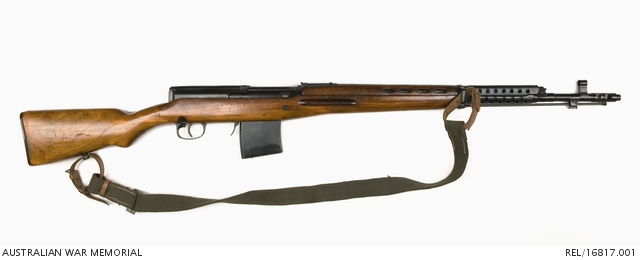
The Tokarev rifle, also known as the SVT 40 is a short stroke, gas-operated rifle with a spring-loaded piston above the barrel. The Tokarev fires the 7.62 x 54 mm cartridge. The rifle was originally intended to become the new service rifle for the Soviet Red Army but production of the rifle was interrupted by the German invasion in 1941 which forced the army to rely on the existing bolt action Mosin Nagant rifle. After WW2, newer weapons designs such as the SKS and the AK47 rendered the Tokarev obsolete. The SVT 40 does not follow the tradition of the Soviet weapons industry where designs are maximized for ruggedness and simplicity. The SVT 40 is more complex in construction than other Soviet military weapons of the time and required frequent cleaning. The rifle is equipped with a bayonet and a ten round detachable magazine. The rifle has an adjustable gas system, a muzzle brake and telescopic sight rails built into the receiver. The first version of the Tokarev rifle was the SVT 38 which saw its combat debut in the 1939–1940 Winter War with Finland. Initially the rifle was poorly received. The rifle's length made it cumbersome to handle, it was complicated to maintain and the magazine had a tendency to fall out of the receiver. A more refined, lighter design referred to as the SVT 40 replaced the SVT 38. Production of the SVT 40 began in July 1940 at Tula, and later at factories in Izhevsk and Podolsk. The German invasion disrupted production of the SVT 40 and large numbers were captured in the early disastrous campaigns on the Eastern front which forced the Soviet military to rely more heavily on the easier to manufacture Mosin Nagant rifle. The popularity of the very successful PPSH submachine gun also diminished interest in the SVT 40. A fully automatic version of the SVT was also produced but suffered from poor stability when firing bursts and greatly reduced barrel life. The rifles also frequently developed mechanical problems resulting from increased stress of automatic fire. Germany used hundreds of thousands of captured SVT rifles the study of which contributed to the development of the Gewehr 43 rifle. The rifle design became obsolete largely because of its complexity in manufacturing and was generally taken out of service by 1955. It is interesting to note that two later very successful rifles, the FN FAL and the SKS borrow on design characteristics of the SVT 40 rifle.
Mosin Nagant M 1938 Rifle:

The M1938 is a carbine version of the 1891 Mosin Nagant rifle. The carbine fires the same round as the 1891 but the barrel was shortened by 21.6 cm . The carbine was intended to be issued to non-front line troops in ancillary roles such as combat engineers and artillerymen.
Mosin Nagant Revolver M 1895:
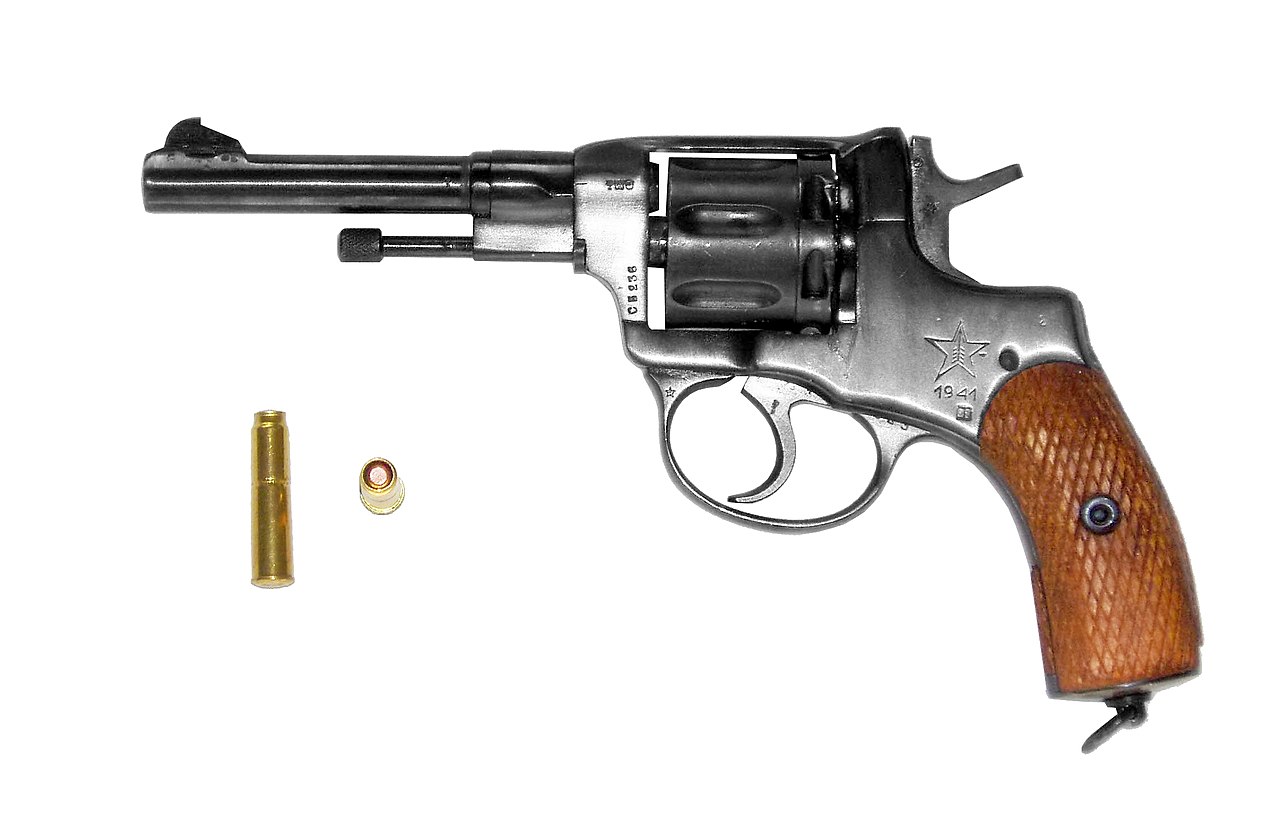
The Nagant M1895 Revolver was designed and produced by Belgian industrialist Léon Nagant for the Russian Empire. (Nagant is also known for the famous Mosin Nagant 1891 rifle also employed in very large numbers by the Russian military). It is a seven shot revolver chambered for a special 7.62×38mm cartridge. The most interesting characteristic of the revolver is the gas seal design which allows the cylinder to move against the barrel when a round is chambered. This mechanism and the unusual design of the cartridge provide a seal to trap propellant gases when fired, increasing the muzzle velocity. In addition to increasing muzzle velocity, the gas seal design allows the revolver to be suppressed effectively. The Nagant 1895 revolver was standard issue for the Russian Imperial Army and police forces replacing the Smith and Wesson Model 3. The revolver was produced at the Tula Arsenal in Russia in two versions : a double-action version for officers, and a cheaper single-action version for privates. The Nagant Revolver achieved iconic status in Russia and was presented as an award to honor party officials. The Nagant Revolver was eventually phased out of production in favor of the Tokarev semi-automatic pistol in 1952. It was retired from use by the postal security service in 2003.The revolver was known for its extreme sturdiness and reliability. A disadvantage of the design is that Nagant revolvers are time consuming to reload. The revolver requires manual ejection of each shell casing. Each round must be individually loaded via a loading port. The Nagant revolver has a heavy trigger pull equal to about 12 pounds. The revolver was widely employed by the Bolshevik secret police, the Cheka, and its Soviet successor agencies, the OGPU and NKVD. Seven Nagant revolvers were used by communist revolutionaries to execute the Russian imperial family and their servants in July 1918. Suppressed M1895 Nagant revolvers were found in the hands of Viet Cong guerrillas during the Vietnam War used as assassination weapons.
Tokarev M 1933 Pistol:
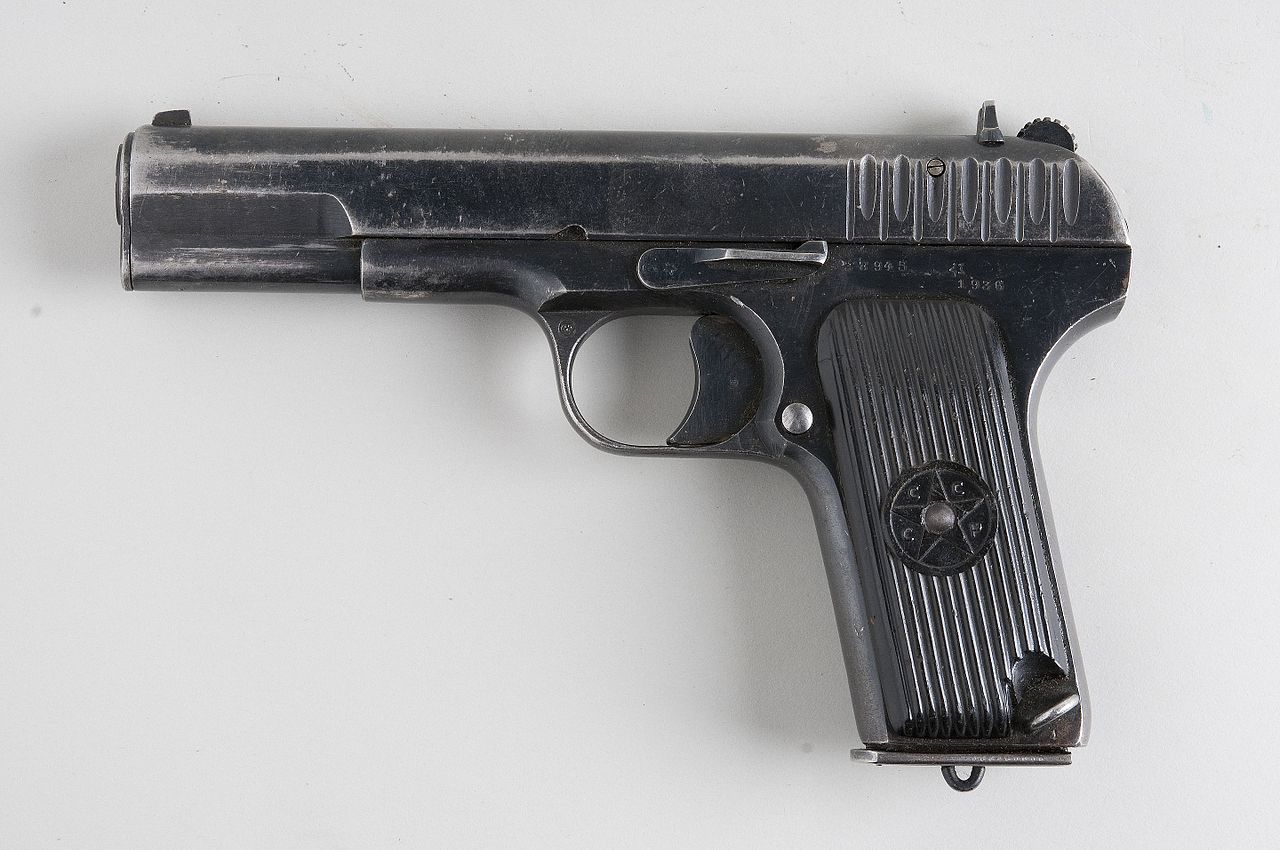
The Tokarev, also known as the TT-30 is a semi-automatic pistol developed in the early 1930's by Fedor Tokarev as a service pistol for the Soviet Military. It replaced the Nagant Revolver. The Tokarev was replaced in 1952 by the Makarov pistol. The Tokarev pistol was manufactured between 1930 and 1936 during which about 93,000 were produced. The TT30 was later redesigned resulting in the TT33. The design borrows from both John Browning's FN Model 1903 semiautomatic pistol, and the M1911 pistol. It is chambered for the 7.62×25mm Tokarev cartridge, which was based on the similar 7.63×25mm Mauser cartridge used in the Mauser C96 pistol. The TT30 is a very rugged and robust pistol. It fires the powerful 7.62×25mm cartridge and has an extremely flat trajectory. Large numbers were produced during World War II and well into the 1950s. The Russian 7.62 mm Model 1930 Type P cartridges fired in the TT33 were nearly identical to the German 7.63×25mm Mauser pistol cartridge which allowed German ammunition to be used in the numerous Tokarev pistols captured by the Wermacht. It is interesting to note that the more powerful Russian 7.62×25mm could not be used as a replacement for the German Mauser pistol cartridge . Several nations have produced copies of the Tokarev including China, Hungary, Romania, North Korea and Poland.
PPSH-41:

The Pistolet-Pulemyot Shpagina or "Shpagin machine pistol" is commonly referred to as the PPSH-41, is a Soviet submachine gun designed by Georgy Shpagin. The PPSH is a magazine-fed selective fire submachine gun using an open bolt and blowback action. The PPSH utilizes a box or drum magazine and fires the 7.62×25mm Tokarev pistol round. This iconic weapon seen in the hands of every Soviet soldier in Stalingrad (and in the hands of some German troops) was produced in large numbers (up to six million) and was used in WW2 and the Korean War. The design of the PPSH was inspired by the very effective Suomi KP/-31 submachine gun which performed especially well in close quarter environments in forests and urban settings. The 71 round drum of the Suomi was copied by the Soviets. The early version of the PPSH was expensive and labor intensive to produce as it contained many milled metal parts. Shpagina was able to re-engineer the weapon design to allow use of cheaper, more easily made stamped metal parts. The new weapon design included a simple gas compensator emerged in 1940 and were being produced in large numbers by 1941. By 1942, 3000 units a day were being produced in Soviet factories. Ease of manufacture largely guided the evolution of its design and allowed the weapon to be built in mass production by unskilled labor using unsophisticated equipment. Barrel production was simplified by using a re-chambered Mosin Nagant barrel sawed in half which could produce two PPSH barrels. Large numbers of the PPSH were captured by the Wermacht. Many of these were modified to use a German cartridge and the MP40 magazine. Magazines for the PPSH were generally matched to the weapon using serial numbers. Weapons using non-matching magazines frequently suffered loss of performance including feeding stoppages and poor fit. Platoons and even entire companies were frequently equipped with the PPSH providing a high amount of short range firepower. PPSH-41 use in Korean War: During the Korean War, large numbers of the PPSH were employed by the Korean People's Army (KPA) and the Chinese People's Volunteer Army (PVA) along side the North Korean Type 49 and the Chinese Type 50, which were both licensed copies of the PPSh-41. The Chinese PPSH was an inaccurate weapon, but its high rate of fire made it effective in close range firefights typically found in the Korean War. US troops in Korea armed with the much more powerful and more accurate M1 Garand were not able to produce the same amount of firepower as enemy forces equipped with the PPSH. At short ranges, firepower was often a crucial determinant in the outcome of an engagement leading some observers to hail the PPSH as the most effective infantry weapon of the war, The American troops referred to it as the "Burp Gun", due to its high rate of fire. The PPSH weighs approximately 12 pounds (5.45 kg) with a loaded 71-round drum and 9.5 pounds (4.32 kg) with a loaded 35-round box magazine. The PPSH is capable of producing a rate of about 1000 rounds per minute. It is a very durable, low maintenance weapon that can be produced using relatively unsophisticated machinery. The PPSH has a chrome lined barrel, wood stock and no fore-grip. A hinged receiver facilitates field-stripping and cleaning of the weapon. The drum magazine has a capacity of 71 rounds although they perform more reliably when loaded with 65 rounds. The drum magazines were slower to reload than the smaller capacity box magazines. The box magazine also provided a convenient hold for the supporting hand.
PPSH-41 use in Korean War:
During the Korean War, large numbers of the PPSH were employed by the Korean People's Army (KPA) and the Chinese People's Volunteer Army (PVA) along side the North Korean Type 49 and the Chinese Type 50, which were both licensed copies of the PPSh-41. The Chinese PPSH was an inaccurate weapon, but its high rate of fire made it effective in close range firefights typically found in the Korean War. US troops in Korea armed with the much more powerful and more accurate M1 Garand were not able to produce the same amount of firepower as enemy forces equipped with the PPSH. At short ranges, firepower was often a crucial determinant in the outcome of an engagement leading some observers to hail the PPSH as the most effective infantry weapon of the war, The American troops referred to it as the "Burp Gun", due to its high rate of fire. The PPSH weighs approximately 12 pounds (5.45 kg) with a loaded 71-round drum and 9.5 pounds (4.32 kg) with a loaded 35-round box magazine. The PPSH is capable of producing a rate of about 1000 rounds per minute. It is a very durable, low maintenance weapon that can be produced using relatively unsophisticated machinery. The PPSH has a chrome lined barrel, wood stock and no fore-grip. A hinged receiver facilitates field-stripping and cleaning of the weapon. The drum magazine has a capacity of 71 rounds although they perform more reliably when loaded with 65 rounds. The drum magazines were slower to reload than the smaller capacity box magazines. The box magazine also provided a convenient hold for the supporting hand
PPS 1943:
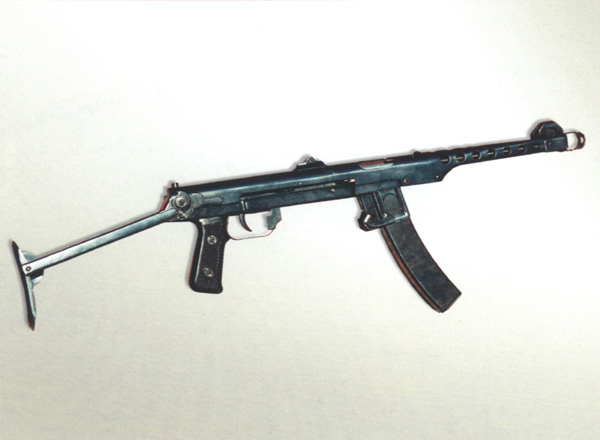
The modernized PPS-43 version of the PPSH 41 entered production in 1943 with design modifications intended to improve manufacturing and safety. "The ventilated heat shield was integrated with the upper receiver cover, both the barrel and shoulder stock were shortened, the stock's locking mechanism was simplified, the casing ejector was moved to the head of the recoil spring guide rod, the magazine well angle was increased in the receiver in order to enhance feeding reliability and the safety was improved to block the trigger and lock the bolt in either the open or closed positions." The modernized PPS-43 version of the PPSH 41 entered production in 1943 with design modifications intended to improve manufacturing and safety. "The ventilated heat shield was integrated with the upper receiver cover, both the barrel and shoulder stock were shortened, the stock's locking mechanism was simplified, the casing ejector was moved to the head of the recoil spring guide rod, the magazine well angle was increased in the receiver in order to enhance feeding reliability and the safety was improved to block the trigger and lock the bolt in either the open or closed positions."



